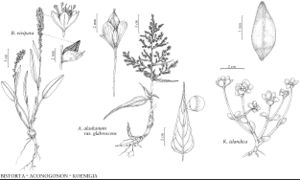Koenigia
Mant. Pl. 1: 3, 35. 1767.
Syst. Nat. ed. 12, 2: 71, 104. 1767.
| Taxon | Illustrator ⠉ | |
|---|---|---|
 | Bistorta vivipara Aconogonon alaskanum var. glabrescens Koenigia islandica | Yevonn Wilson-Ramsey Yevonn Wilson-Ramsey Yevonn Wilson-Ramsey |
Herbs, annual; taprooted. Stems decumbent, ascending, or erect, glabrous. Leaves cauline, alternate or subopposite, petiolate; ocrea persistent, chartaceous; blade spatulate-ovate to orbiculate, margins entire. Inflorescences terminal, paniclelike or cymelike, not pedunculate. Pedicels absent or present. Flowers bisexual, 3–10 per ocreate fascicle, bases not stipelike; perianth nonaccrescent, greenish, often tinged white or pink distally, narrowly campanulate, glabrous or occasionally with scattered glands; tepals 3 [4], distinct, sepaloid, monomorphic; stamens (1–) 3 [–5]; filaments distinct, free, glabrous; anthers white or yellowish, ovate to elliptic; styles 2 (–3), erect, distinct; stigmas capitate. Achenes included or barely exserted, light-brown or brown to black, unwinged, unevenly 2-gonous, rarely 3-gonous, glabrous. Seeds: embryo curved. x = 7.
Distribution
Alpine, arctic, and circumpolar, n North America, s South America, n Europe, e Asia
Discussion
Species 6 (1 in the flora).
The five other species of Koenigia are endemic to high mountains of southeastern Asia, primarily the Himalayas (O. Hedberg 1997). K. Haraldson (1978) and L.-P. Ronse Decraene and J. R. Akeroyd (1988) placed Koenigia close to Aconogonon based on morphological data. Preliminary molecular data seem to support that relationship (A. S. Lamb Frye and K. A. Kron 2003).
Selected References
Lower Taxa
"/2" is not declared as a valid unit of measurement for this property.